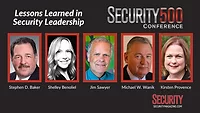Top Lessons Learned from the Security 500 Conference
From the highest technology solutions against cyber crime, to the low-technology sandbags that saved $4 billion of Goldman Sachs’ New York City and Jersey City buildings against Superstorm Sandy, to the far-reaching and thought-provoking keynote presentation by Roland Cloutier, Vice President & Chief Security Officer of ADP, the Security 500 Conference gathered security’s thought leaders for a day of provoking and valuable networking.
Victimized by Superstorm Sandy itself in November and rescheduled to February 12, it is no surprise that the first panel focused on business resilience and lessons learned from Sandy. At the heart of successful resilience programs was strong communication with employees and stakeholders, redundancy against failures and moving into action well before the storm arrived. Panelists Ken Damstrom of Goldman Sachs, Daniel Holmes of Honeywell and Ed Goetz of Exelon shared their biggest lessons from the experience, especially the underestimation of the effect the storm would have on their employees’ families and homes, making the employees unavailable or unable to come to work as scheduled. As a result, resiliency plans have already been updated to include the housing and support of family members.
Security Associate Editor Claire Meyer moderated the panel Transcending Security: Empowering Your Business, that shared how successful leaders work with their executive peers to align with organizational goals. Russ Cancilla of Baker Hughes, Tim Janes of Capital One and Dennis Treece of the Massachusetts Port Authority shared the interesting notion that they do not talk to their executives about security. Rather, they listen. Talking security lowers the discussion the same way an HR executive discussing mundane HR policies would. Business leaders want to discuss their agenda and gain buy-in and support for success. By focusing on their internal customer’s goals, they earn the credibility and respect necessary to manage risk and security effectively. Avoid using law enforcement metrics such as fraud, theft or arrests – those paint you as a security person, not a business person.
Everyone learned a “new word,” so to speak, during the 3rd Party Oversight: Securing Procurement panel that was moderated by Brad Brekke of Target. After payroll, the next largest outflow of cash for an organization is procurement or purchasing, which is primarily based on trust and technology. The research on bidding vendors, their ownership and the delivery of goods and services is often done without best practices for oversight and risk management. Business leaders Bill Anderson of Ryder, Kevin Donovan of Johnson and Johnson and James Murphy of Kimberly Clark discussed their organization’s oversight programs.
Key learnings included the risk that if a vendor is doing something illegal or inappropriate, it will come back to the company creating brand, legal and financial issues. Another risk is allowing third parties too much access to information. Enforcement and auditing is critical to ensure compliance of legal, regulatory and company standards. The biggest creator of procurement risk is outsourcing. “Trust but verify” is key to a successful, global oversight program.
The cyber crime panel, Time to Play Offense!, was moderated by Lynn Mattice of Mattice and Associates. The initial question asked was why the federal government was not more helpful with threat information. Steven Chabinsky, Former Deputy Assistant Director for the Federal Bureau of Investigation, Cyber Division, explained that while the government shared some information on vulnerabilities in private sector systems, sharing more was not the answer to the problem. The two types of threat actors include those seeking an opportunity to steal and those targeting a specific private organization that has something unique that they want. The latter is the most difficult to prevent. Chabinsky summarized that the government is making it worse because they are simply not going after the bad guys but just telling businesses about them.
Mattice was joined by panelists Marene Alison of Johnson and Johnson, Paul Poh of Fiserv and Ed Goetz of Exelon. The discussion focused on a number of key issues facing organizations that make them vulnerable, including basic issues such as outsourcing of IT, giving external organizations access to your systems and allowing vendors onto your network in a manner that can bring infections.
The summary is that government has the legal ability to take action but is not doing so. Businesses have the technical ability to take action but are legally bound from doing so. Offense and action are necessary, though, because it is not an “if,” but a “when” your organization will face a broad range of cyber intrusion.
Roland Cloutier, CSO & VP of ADP spoke at the dinner about the security’s future moving from silos to a single, holistic organization that does not align with the business, but is within the business. By integrating risk and security processes within business operations through intelligent ecosystems that identify and manage threats, organizations will mitigate threats by eliminating vulnerabilities in real-time, thereby securing the business.
Special thanks to the Security Industry Association for its support to produce the event. And thanks to our attendees, speakers and sponsors that participated in the program. Information about the May 16th event in Palo Alto will be forthcoming.
Looking for a reprint of this article?
From high-res PDFs to custom plaques, order your copy today!





